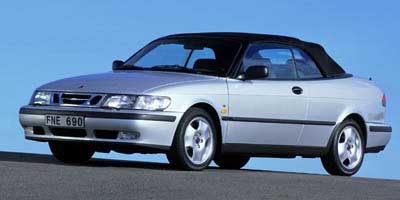New Car/Review

1999 Saab 9-3 SE Convertible
By Tom Hagin
 Saab Full Line Video footage (4:09) 28.8, 56k, or 200k
Saab Full Line Video footage (4:09) 28.8, 56k, or 200k
SPECIFICATIONS
Manufacturer's Suggested Retail Price $ 42,995
Price As Tested $ 43,570
Engine Type DOHC 16-valve 2.0 Liter I4 w/SPFI*
Engine Size 121 cid/1985 cc
Horsepower 200 @ 5500 RPM
Torque (lb-ft) 209 @ 4600 RPM
Wheelbase/Width/Length 102.6"/67.4"/182.3"
Transmission Five-speed manual
Curb Weight 3221 pounds
Fuel Capacity 16.9 gallons
Tires (F/R) 205/50ZR16
Brakes (F/R) Disc (ABS)/disc (ABS)
Drive Train Front-engine/front-wheel-drive
Vehicle Type Four-passenger/two-door
Domestic Content Two percent
Coefficient of Drag (Cd.) 0.34
PERFORMANCE
EPA Economy, miles per gallon
city/highway/average 19/27/23
0-60 MPH 7.0 Seconds
1/4 mile (E.T.) 16.0 seconds 92.5 mph
Top speed N/A
* Sequential multi-port fuel injection
Twenty-two years ago, Saab decided to inject its line of well-built, conservative vehicles with some spice. That's when the company introduced the Saab Turbo, a car that almost created a category all by itself. A ragtop followed 10 years later, and became a choice of young urban professionals across the U.S.
Since then it's evolved into today's 9-3, which comes as a coupe, sedan or as our test vehicle of the week, a convertible.
OUTSIDE - All Saab models stand apart from the generic sedan profile that dominates the market. There's a new grille (patterned after the upscale Saab 9-5) which has a winged look to its centerpiece. The nose has new bumper covers and headlights and there's changes to the rear end too. Convertibles benefit from a redesigned fabric top that uses hydraulic operation instead of the previous model's electric motors. Also, there are fewer sewn panels to weaken and fail and the headliner insulation is thicker and more sound proof. Drip channels are integrated into the top to keep water from entering the car. Lowering the top is easy: twist a windshield header latch and press a button between the seats. The whole assembly disappears into a well behind the rear seats and is protected by a bag inside the trunk. Lastly, a clamshell-like rigid cover snaps shut to conceal the opening. The previous three-spoke alloy wheels have been replaced with with five-spoke alloys.
INSIDE - Inside, drivers are greeted by an upright black and gray dashboard, Saab's trademark joystick-operated dash vents and a new four-spoke, leather-wrapped steering wheel on SE models. The deeply contoured seats are now more bolstered, and in the case of SE models, covered in leather upholstery. The climate controls are now easier to use, while visibility has been improved via a taller rear window. Four people fit in the 9-3 in relative comfort, but five adults is pushing things. Standard features include automatic climate control, eight-way power front seats, power windows, outside mirrors and door locks, telescoping steering column, cruise control, multi-function computer, a fold-down rear seat and an AM/FM/cassette stereo with six speakers.
ON THE ROAD - Saab calls its new SE powerplant High Output Turbo, or HOT. It's an inline four cylinder with dual overhead camshafts, 16 valves, and is turbocharged to produce 200 horsepower and 209 pound-feet of torque. Standard 9-3 models are also turbocharged, by get by with 185 horsepower and 194 pound-feet of torque, depending on the transmission choice. Much of this torque is available at low rpms, and teamed with new ratios for the five-speed manual transmission, it gives excellent launch off-line, and a respectable sprint to 60 mph in seven seconds. Clutch operation has been enhanced with hydraulic operation instead of the older cable-operation. Torque-steer, a phenomenon that occurs in most high-power front wheel-drive cars, is prevalent when the turbo "spools" and the unit produces power in a furious rush, but that's part of what makes the 9-3 so much fun to drive.
BEHIND THE WHEEL - Saab redesigned the platform of the second- generation 900 models back in 1993. It again made improvements last year in the form of stiffening, which comes in handy when a roof is absent. We felt some cowl shake and shudder when we drove over broken pavement and railroad tracks, though not so enough to disturb the ride. The 9-3's four-wheel independent suspension uses strut-type components up front and a trailing arm setup in back. For '99 Saab engineers changed the suspension tuning somewhat. By altering the geometry and lengthening the travel of the struts, bumps are absorbed better and the ride feels more composed. The steering is nicely weighted and now features a new, quicker ratio and increased power assist. Braking is handled by four-wheel discs with an anti-lock braking system at both ends.
SAFETY - Dual dashboard and side-impact airbags, ABS, active head restraints and side-impact door beams are standard.
OPTIONS - There were no options on our test car. Destination charge is $575.


